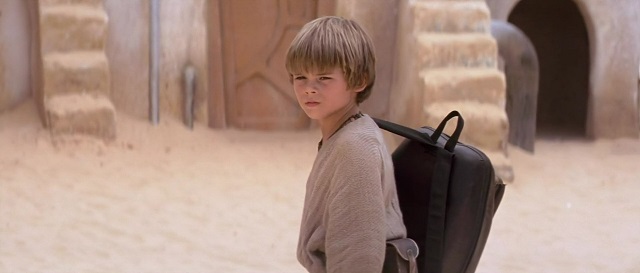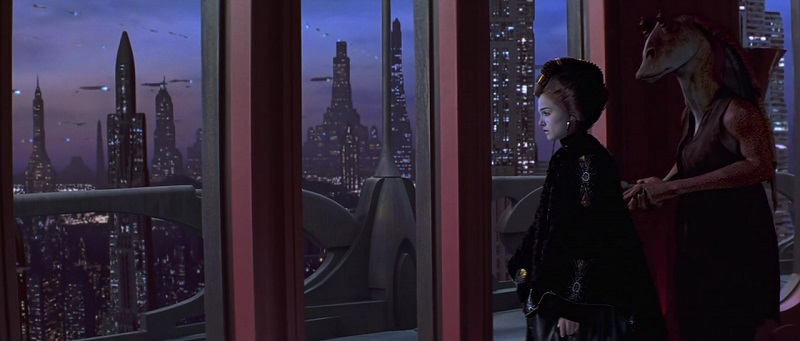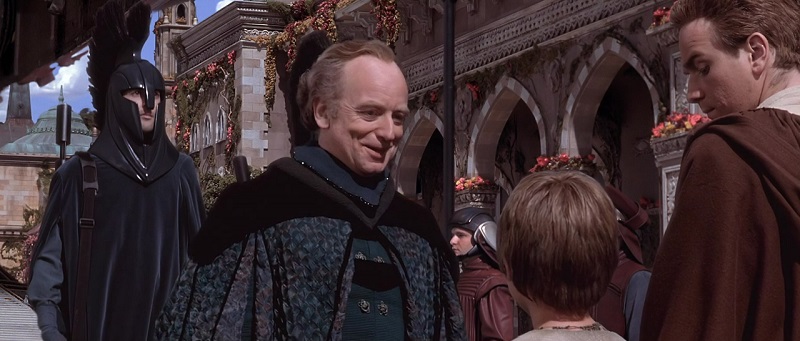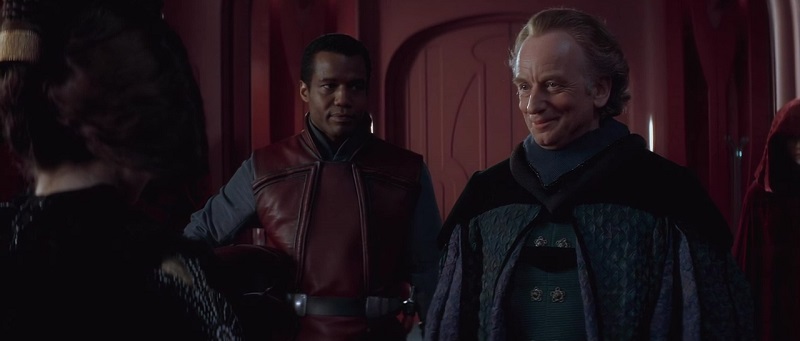As The Phantom Menace turns twenty it has encouragingly ushered forth open reappraisal, new discussions, and even admiration for much of the creative work that went into one of the most accidentally incendiary films of the modern era. As someone who loved it as an impressionable, Anakin-aged nine-year-old in 1999 this is music to my ears. I have for much of its lifetime found it to be a curiously easy watch, rather than the repellent slugfest many of its loudest critics label it. As I’ve grown older I’ve appreciated more and more some of George Lucas’s flourishes that were imperceptible or just “part of the furniture” to my younger, less-developed critical faculty. I am also more than aware of the film’s many transgressions and faults. I understand completely why the film doesn’t work for so many, and why it was upsetting or frustrating.
In an odd way though, many of The Phantom Menace’s mistakes form part of its appeal now for me as an adult. While on the surface it is a children’s storybook of a film and is (relatively) less mature than what is to come, this belies a story that is steeped in some of the noir traditions that would become more obvious in Attack of the Clones, and as mentioned in Sarah Dempster’s excellent anniversary piece, is the beginning of the end of the galaxy far, far away’s Belle Epoque. Beyond that, with respect to what may be in store for us with The Rise of Skywalker, it is also the best showcase for one of the silver screen’s most diabolical and terrifying villains: Sheev Palpatine.
Angels and demons
Star Wars is typically summed up as a classic battle of good against evil, white hats and black hats, a straightforward dichotomy where we know who the heroes are, and we certainly know who the villains are. This is of course not strictly true, as key characters either flit across that boundary or flirt with it as the saga rolls on. But at its internally chronological starting point, the concepts of good and evil are vastly less clear than they are in A New Hope. This is a grander, slicker galaxy, more epic in scope and size and wonder, but with that comes complexity. We start off with Star Peace, so to speak – no state of war rages, just a simmer of angst and a dispute over taxation.
Taken on its own, a fundamental structural problem with The Phantom Menace is that it lacks a classic functioning protagonist. The stoic Jedi are not for us to pin our hopes and dreams on lacking any sort of emotional arc as they do, and Queen Amidala is obfuscated by her trickery not only from her Trade Federation adversaries but the audience too. For the first act of the film, much of the action feels more like a medieval book of hours than an adventure serial – monotone utterances, conferences between kings, queens, viceroys, monks. Yes there is “action” in the classic sense but it is something of a deliberate cacophony – the battle droids are a joke, no match for Jedi in full flight, and so the sense of danger is as muted as everything else. Qui-Gon even mentions that the scenario is “trivial”, so our sense of investment at the start is always going to be more detached than it is with “stolen Death Star plans go go go”.

It isn’t until the second act, after the queen and the Jedi run the gauntlet and escape the clutches of the Federation, that the characters we would expect emerge, and they embody the good and evil dichotomy in the most dramatic contrast: the cherubic Anakin, an “angel” in the form of Padmé as a distinct character, and the demonic Darth Maul…who ultimately will not harass the heroes until more than halfway through the movie. The clash between Maul and Qui-Gon, the opening salvo in what will ultimately be the revenge of the Sith, feels like it roars in on a speeder bike from an entirely different Star Wars movie – here finally is the black hat, here is the real threat. But our heroes still are only nudging the plot, far from the rowdy fire-from-the-hip swashbuckling of Han, Luke and Leia.
This is of course antithetical to the original trilogy and not conventionally wise for a movie that is built to entertain, but George Lucas is too good a filmmaker for these decisions to render the film inert and useless, as it might in the hands of a lesser writer/director. Context affords these curious decisions an entirely different type of asset in the early stanzas of The Phantom Menace, in that this is a world in which nobody knows the Rube Goldberg machine has been set off. The villain of the piece is so brilliant that the heroes cannot even conceive of whom they are fighting, what they are fighting for, and what they might achieve if they should succeed. They don’t even know what success is. If you think The Phantom Menace is inessential, you’re missing the forest for the trees – the villain has constructed a narrative of conflict for conflict’s sake, a fight without meaning, and trapped the good guys within it. And it is far more diabolical than the machines of The Phantom Menace’s 1999 cousin The Matrix, because whatever shape victory takes for these clueless heroes in their matrix means a victory tenfold for Palpatine.
Falsity and futility
Once the characters reach the glittering ecumenopolis Coruscant, Lucas sneakily deploys the best scene of the film, and one of the most darkly comic in the Skywalker saga. The young Queen Amidala confers with her trusted representative on the capital, Senator Palpatine. Here Ian McDiarmid does some of his best work – the lightly chiding tone, the casually idle suggestions to the impressionable young Padmé, and a summary of the preceding action: nobody cares. And more to the point, nothing can be done! The whole voyage to Coruscant is almost gleefully dashed by Palpatine. Perhaps he knew that Amidala would make it to Coruscant, perhaps he didn’t, but he makes it work, redirecting the young queen’s anger and naïveté at Supreme Chancellor Valorum.
Again, this is a large part of why the prequel heroes will frustrate an audience – try as they might, their best efforts only further the cause of Palpatine. Padmé is doomed to this fate repeatedly over the course of the trilogy – first toppling Valorum, then ensuring the opening of hostilities on Geonosis, and then of course inadvertently being a catalyst for the creation of Darth Vader. This is not to say that she isn’t a strong character – she is, and was sadly robbed of her redemptive defiance in Revenge of the Sith’s cut scenes, but like Anakin her strength is harnessed by the unseen Darth Sidious and made to serve evil in ignorance.

These elements are common in noir – characters locked in a futile struggle, attempting to “dig up” out of the hole but only deepening it. The characters being unaware of their futility despite being given the clues is all part of it. There is again a dark humor to it, but there is also an intended frustration – we are fascinated either by how bad it can get or the question of whether this fate can be escaped. Often characters are presented with information early on that would otherwise dissuade them from the actions that doom them. Not so in The Phantom Menace. The Jedi are only faintly served by the Force – Obi-Wan Kenobi coins the “bad feeling” about something elusive (a…phantom menace) and Qui-Gon muses that there is something else behind the Federation’s actions. But these concerns give way to the panacea of the Chosen One prophecy, and the concern over the return of the Sith. The Jedi take their eye off the ball, and as we all know that will ultimately spell their doom.
The phantom of the space opera
In spite of all the deceit, Star Wars is still gifted with a rather useful device that gives you all the clues as to what is going on, and that is courtesy of John Williams. The full-blooded score for The Phantom Menace is something of a departure, however, from the scores of the original trilogy, notably with the expansion of vocals. These were first used substantially in Return of the Jedi for the Emperor’s theme, and Luke’s dramatic flurry of lightsaber blows against his father, but here they permeate the musical soundscape. The first appearance of Darth Sidious is heralded by the whispered lyrics of “Duel of the Fates” before the “reprise” of his Return of the Jedi theme – an unsettling harbinger of things to come. More disturbing is the subversion of the idea of a victory parade, a parallel to A New Hope’s triumphant march derived from the Force Theme; at the end of The Phantom Menace, the heroes celebrate casting off the yoke of Federation control to an upbeat children’s choir…to the tune of the Emperor’s theme. Even the symbol of peace held aloft by Boss Nass is a ball of lightning, Palpatine’s go-to method of violence.
This is why The Phantom Menace is the darkest, most disturbing entry in the Skywalker saga. Yes, it lacks the apocalyptic chaos of Revenge of the Sith, the brutal lessons of The Empire Strikes Back, and the cruel denials of The Last Jedi. Yes, parts of it look like the Windows XP background. But here the characters don’t even know what evil is. They don’t know what they’ve done. They don’t even know who they are – pawns that think they are queens and bishops. To not know the scope of what you are confronting and to live in ignorance is surely more frightening a prospect than having at least a concept of what you must fight. Mace Windu and Yoda muse over whether Darth Maul was the master of the Sith or not – it took the death of Qui-Gon Jinn for them to be sure that their ancient enemies had even returned, let alone to humor the idea that this might only be the tip of the iceberg.
Even the villains themselves don’t understand how unimportant what they are doing is. The true goal of the blockade of Naboo pays off at the end of the second act, when Palpatine marches in, looking like he has dined exclusively on canaries – the frontrunner in the chancery election chiefly due to sympathy towards his imperiled homeworld. This is basically the ending of Watchmen: the bad guy has won already! What follows matters to Naboo and its queen of course, but in the grand scheme of Palpatine’s plan it is a charade. It is one of the few times Palpatine is genuinely surprised in the saga – Queen Amidala’s compassion for her people causes her to charge headlong back into danger. This is confusing but largely uninteresting to Palpatine. There is an opportunity to draw Jedi blood, but really it all comes back to his directive: “Wipe them out…all of them.”
The third act, expansive and spectacular as it is, is a prelude to the big kahuna of futile conflicts, the Clone Wars. The climactic lightsaber duel is free of dialogue – this is more about ancient religious enemies coming into conflict after a thousand years of silence. There is no emotion, at least not until Qui-Gon hits the deck, and yet the stakes feel higher here than elsewhere. There are grim portents of the future everywhere, from the sniveling Nute Gunray being of paramount importance despite having no agency, as he will be again a decade later as part of the sham Separatist movement, to the centrally-controlled battle droids, who pre-figure the clone troopers who will turn into stormtroopers at the flick of a switch. Sidious parades these elements in front of the clueless heroes of this morbid show to taunt them, and then when it is all over he arrives, the newly minted Supreme Chancellor, to blithely share in the celebration with his most hated enemies.

The Phantom Menace recalls Jean Renoir’s masterpiece The Rules of the Game to an extent. That film too features characters of a certain class locked in a defined societal construct as the forces of evil that will consume them grow unchecked. Here the construct is an ersatz and dysfunctional version of a Star Wars adventure, and the issue is not so much morality but ignorance and arrogance. The quality of life up to this point for many of the characters is so good that they can’t comprehend the depths to which the state is rotten. They discover slavery and ignore it. They transcend bigotry for a military advantage. They take a boy from his mother to fulfill a prophecy. The concept of Darth Sidious’s master plan is extensive, but much of it hinges on whether or not he can pull his hood down far enough that it obscures his face. He is a great villain not because he is a master of the Force or because he can see the future, but because he can see what is weak within this Belle Epoque and exploit it ruthlessly.
This is not to say that The Phantom Menace is nearly as good as The Rules of the Game, nor even that it is necessarily a good or effective film. It is, however, a different film viewed through the prism of its puppet master, and when its structural problems are taken as part of the text rather than a glaring omission by a storyteller who is typically more savvy than some of his critics. It also, curiously enough, works best as a prequel, which is to say it is better knowing what is in store for these characters than trying to purge your mind of what is to come and treat this as “the beginning”. If Palpatine returns in some substantial form in The Rise of Skywalker, The Phantom Menace may yet become even more compelling with age and context.

